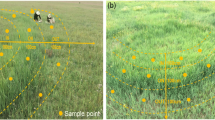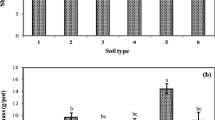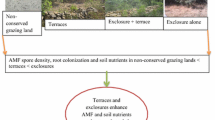Abstract
Stimulation of plant productivity caused by Agaricus fairy rings has been reported, but little is known about the effects of these fungi on soil aggregation and the microbial community structure, particularly the communities that can bind soil particles. We studied three concentric zones of Agaricus lilaceps fairy rings in Eastern Montana that stimulate western wheatgrass (Pascopyrum smithii): outside the ring (OUT), inside the ring (IN), and stimulated zone adjacent to the fungal fruiting bodies (SZ) to determine (1) soil aggregate proportion and stability, (2) the microbial community composition and the N-acetyl-β-d-glucosaminidase activity associated with bulk soil at 0–15 cm depth, (3) the predominant culturable bacterial communities that can bind to soil adhering to wheatgrass roots, and (4) the stimulation of wheatgrass production. In bulk soil, macroaggregates (4.75–2.00 and 2.00–0.25 mm) and aggregate stability increased in SZ compared to IN and OUT. The high ratio of fungal to bacteria (fatty acid methyl ester) and N-acetyl-β-d-glucosaminidase activity in SZ compared to IN and OUT suggest high fungal biomass. A soil sedimentation assay performed on the predominant isolates from root-adhering soil indicated more soil-binding bacteria in SZ than IN and OUT; Pseudomonas fluorescens and Stenotrophomonas maltophilia isolates predominated in SZ, whereas Bacillus spp. isolates predominated in IN and OUT. This study suggests that growth stimulation of wheatgrass in A. lilaceps fairy rings may be attributed to the activity of the fungus by enhancing soil aggregation of bulk soil at 0–15 cm depth and influencing the amount and functionality of specific predominant microbial communities in the wheatgrass root-adhering soil.



Similar content being viewed by others
References
Acosta-Martínez V, Cruz L, Sotomayor-Ramírez D, Pérez-Alegría L (2007) Enzyme activities as affected by soil properties and land use in a tropical watershed. Appl Soil Ecol 35:35–45
Acosta-Martínez V, Zobeck TM, Allen V (2004) Soil microbial, chemical and physical properties in continuous cotton and integrated crop-livestock systems. Soil Sci Soc Am J 68:1875–1884
Bååth E, Anderson TH (2003) Comparison of soil fungal/bacterial ratios in a pH gradient using physiological and PLFA-based techniques. Soil Biol Biochem 35:9355–9963
Bailey VL, Smith JL, Bolton H (2002) Fungal-to-bacterial ratios in soils investigated for enhanced C sequestration. Soil Biol Biochem 34:997–1008
Bayliss-Elliott JS (1926) Concerning “fairy rings” in pastures. Ann Appl Biol 13:277–288
Beare MH, Hendrix PF, Coleman DC (1994) Water-stable aggregates and organic matter fractions in conventional and no-tillage soils. Soil Sci Soc Am J 58:777–786
Bonanomi G, Mingo A, Incerti G, Mazzoleni S, Allegrezza M (2012) Fairy rings by a killer fungus foster plant diversity in species-rich grassland. J Veg Sci 23:236–248
Brimecombe MJ, De Leij FA, Lynch JM (2001) The effects of root exudates on rhizosphere microbial populations. In: Pinton R, Varanini Z, Nannipieri P (eds) The rhizosphere. Biochemistry and organic substances at the soil–plant interface. Marcel Dekker, New York, pp 95–140
Buyer JS, Roberts DP, Russek-Cohen ER (1999) Microbial community structure and function in the spermosphere as affected by soil and seed type. Can J Microbiol 45:138–144
Buyer JS, Sasser M (2012) High throughout phospholipid fatty acid analysis of soils. Appl Soil Ecol 61:127–130
Caesar-TonThat TC (2002) Soil binding properties of mucilage produced by a basidiomycete fungus in a model system. Mycol Res 106:930–937
Caesar-TonThat TC, Lenssen AW, Caesar AJ, Sainju UM, Gaskin JF (2010) Effects of tillage on microbial populations associated to soil aggregation in dryland spring wheat system. Eur J Soil Biol 46:119–127
Cromack JK, Caldwell BA (1992) The role of fungi in litter decomposition and nutrient cycling. In: Carroll GC, Wicklow DT (eds) The fungal community: its organization and role in the ecosystem. Marcel Dekker, New York, pp 653–668
Degens BP (1997) Macro-aggregation of soils by biological bonding and binding mechanisms and the factors affecting these: a review. Aust J Soil Res 35:431–459
Edward PJ (1984) The growth of fairy rings of Agaricus arvensis and their effect upon grassland vegetation and soil. J Ecol 72:505–513
Ekenler M, Tabatabai MA (2002) B-Glucosaminidase activity of soils: effect of cropping systems and its relationship to nitrogen mineralization. Biol Fertil Soils 36:307–376
Feng Y, Motta AC, Reeves DW, Burmester CH, van Santen E, Osborne JA (2003) Soil microbial communities under conventional-till and no-till continuous cotton systems. Soil Biol Biochem 35:1693–1703
Fisher RF (1977) Nitrogen and phosphorus mobilization by the fairy ring fungus, Marasmius oreades (Bolt) Fr. Soil Biol Biochem 9:239–241
Fox RTV (2006) Fungal foes in your garden: fairy ring mushrooms. Mycologist 20:36–37
Frostegård A, Bååth E, Tunlid A (1993) Shifts in the structure of soil microbial communities in limed forests by phospholipid fatty acid analysis. Soil Biol Biochem 25:723–730
Gannon JT, Manilal VB, Alexander M (1991) Relationship between cell surface properties and transport of bacteria through soil. Appl Environ Microbiol 57:190–193
Gilchrist JE, Campbell JE, Donnelly CB, Peeler JT, Delaney JM (1973) Spiral plate method for bacterial determination. Appl Microbiol 25:244–252
Glandorf DCM, Sluis IVD, Anderson AJ, Bakker PAHM, Schippers B (1994) Agglutination, adherence and root colonization by fluorescent pseudomonads. Appl Environ Microbiol 60:1726–1733
Glick BR (1995) The enhancement of plant growth by free-living bacteria. Can J Microbiol 41:109–117
Griffiths B, Ritz K, Ebblewhite N, Dobson G (2009) Soil microbial community structure: effects of substrate loading rates. Soil Biol Biochem 31:145–153
Hachisuka Y, Kozuka S, Tsujikawa M (1984) Exosporia and appendages of spores of Bacillus species. Microbiol Immunol 28:619–624
Hakamori S, Igarashi Y (1993) Gangliosides and glycosphingolipids as modulators of cell growth, adhesion, and transmembrane signaling. Adv Lipid Res 25:147–162
Hu S, Coleman DC, Beare MH, Hendrix PF (1995) Soil carbohydrates in aggrading and degrading agrosystems: influences of fungi and aggregates. Agric Ecosyst Environ 54:77–88
Jansson PE, Lindberg B (1983) Structural studies of gellan gum, an extracellular polysaccharide elaborated by Pseudomonas elodea. Carbohydr Res 124:135–139
Jarvis B, Lach VH, Wood JM (1977) Evaluation of the spiral plate maker for the enumeration of micro-organisms in foods. J Appl Bacteriol 43:149–157
Jucker BA, Harms H, Zehnder AJB (1996) Adhesion of the positively charged bacterium Stenotrophomonas (Xanthomonas) maltophilia 70401 to glass and Teflon. J Bacteriol 178:5472–5479
Kemper WD, Rosenau RC (1986) Aggregate stability and size distribution. In: A. Klute (ed) Methods of soil analysis: physical and mineralogical methods, Part 1, 2nd edn. ASA, SSSA Spec Publ No. 9, Madison, pp. 425–442
Konkol N, McNamara CJ, Mitchell R (2010) Fluorometric detection and estimation of fungal biomass on cultural heritage materials. J Microbiol Meth 80:178–182
Lartey RT, Caesar-TonThat TC, Lenssen AW, Eckhoff J, Hanson S, Evans RG (2010) Direct PCR based detection of Cercospora beticola in field soils. Plant Dis 94:1100–1104
Latour X, Corberand T, Laguerre G, Allard F, Lemaneau P (1996) The composition of fluorescent pseudomonad populations associated with roots is influenced by plant and soil type. Appl Environ Microbiol 62:2449–2456
Li B, Logan BE (2004) Bacterial adhesion to glass and metaloxide surfaces. Colloid Surf B 36:81–90
Marilley L, Aragno M (1999) Phylogenetic diversity of bacterial communities differing in degree of proximity of Lolium perenne and Trifolium repens roots. Appl Soil Ecol 13:127–136
Mathur SP (1970) Degradation of soil humus by the fairy ring mushroom. Plant Soil 33:717–720
Meek BD, Rechel ER, Carter LM, DeTar WR, Urie AL (1992) Infiltration rate of a sandy loam soil: effects of traffic, tillage, and plant roots. Soil Sci Soc Am J 56:908–913
Mehmannavaz R, Prasher SO, Ahmad D (2001) Cell surface properties of rhizobial strains isolated from soils contaminated with hydrocarbons: hydrophobicity and adhesion to sandy soil. Process Biochem 36:683–688
Mendes IC, Bandick AK, Dick RP, Bottomley PJ (1999) Microbial biomass and activities in soil aggregates affected by winter cover crops. Soil Sci Soc Am J 63:873–881
Miller HJ, Liljeroth E, Henken G, Van Veen JA (1990) Fluctuations in the fluorescent pseudomonad and actinomycete populations in the rhizosphere and rhizoplane during growth of spring wheat. Can J Microbiol 36:254–258
Miller M, Palojarvi A, Rangger A, Reeslev M, Kjoller A (1998) The use of fluorogenic substrates to measure fungal presence and activity in soil. Appl Environ Microbiol 64:613–617
Mills AL (2003) Keeping in touch: microbial life on soil particle surfaces. Adv Agron 78:1–43
NRCS (2002) Plant fact sheet: western wheatgrass. USDA Natural Resources Conservation Service, Washington
Oka N, Hartel PG, Finlay-Moore O, Gagliardi J, Zuberer DA, Fuhrmann JJ, Angle JS, Skipper HD (2000) Misidentification of soil bacteria by fatty acid methyl ester (FAME) and BIOLOG analyses. Biol Fertil Soils 32:256–258
Parham JA, Deng SP (2000) Detection, quantification and characterization of β-glucosaminidase activity in soil. Soil Biol Biochem 32:1183–1190
Prosser JI (2007) Microorganisms cycling soil nutrients and their diversity. In: Van Elsas JD, Jansson JK, Trevors JT (eds) Modern soil microbiology, 2nd edn. CRC–Taylor & Francis, Boca Raton, pp 237–261
Reasoner DJ, Geldreich EE (1985) A new medium for the enumeration and subculture of bacteria from potable water. Appl Environ Microbiol 49:1–7
Rasse DP, Smucker AJM (1998) Root recolonization of previous root channels in corn and alfalfa rotations. Plant Soil 204:203–212
Romani AM, Fisher H, Mille-Lindblom C, Tranvik LJ (2006) Interactions of bacteria and fungi on decomposing litter: differential extracellular enzyme activities. Ecology 87:2559–2569
Sabra W, Zeng A-P, Deckwer WD (2001) Bacterial alginate: physiology, product quality and process aspects. Appl Microbiol Biotechnol 56:315–325
Shantz HL, Piemeisel RL (1917) Fungus fairy rings in eastern Colorado and their effect on vegetation. J Agr Res 9:191–245
Six J, Elliott ET, Paustian K (2000) Soil macroaggregate turnover and microaggregate formation: a mechanism for C sequestration under no-tillage agriculture. Soil Biol Biochem 32:2099–2103
Smit E, Leeflang P, Gommans S, Van Den Broek J, Van Mil S, Wernars K (2001) Diversity and seasonal fluctuations of the dominant members of the bacterial soil community in a wheat field as determined by cultivation and molecular methods. Appl Environ Microbiol 67:2284–2291
Stamets P, Chilton JS (1983) Sterile technique and agar culture. In: Stamets P, Chilton JS (eds) The mushroom cultivator. A practical guide to growing mushroom at home. Agarikon””, Olympia, pp 15–40
Stoline MR (1981) The status of multiple comparisons: simultaneous estimation of all pairwise comparisons in one-way ANOVA designs. Am Stat 35:134–141
Tabatabai MA, Bremner JM (1969) Use of ρ-nitrophenyl phosphate for assay of soil phosphatase activity. Soil Biol Biochem 1:301–307
Tamura K, Peterson D, Peterson N, Stecher G, Nei M, Kumar S (2011) MEGA5: Molecular Evolutionary Genetics Analysis using maximum likelihood, evolutionary distance, and maximum parsimony methods. Mol Biol Evol 28:2731–2739
Tisdall JM, Oades JM (1982) Organic matter and water-stable aggregates in soils. J Soil Sci 33:141–163
Toohey JI (1983) Fungus fairy rings in soil etiology and chemical ecology. Can Field Nat 97:9–15
Van Overbeek L, Van Elsas JD (1997) Adaptation of bacteria to soil conditions: application of molecular physiology in soil microbiology. In: Van Elsas JD, Trevors JT, Wellington EM (eds) Modern soil microbiology. Marcel Dekker, New York, pp 441–477
Waldrop MP, Balser TC, Firestone MK (2000) Linking microbial community composition to function in a tropical soil. Soil Biol Biochem 32:1837–1846
Watt M, McCully ME, Jeffree CE (1993) Plant and bacterial mucilage of the maize rhizosphere: comparison of their soil binding properties and histochemistry in a model system. Plant Soil 151:151–165
Gavlak R, Horneck D, Miller RO, Kotuby-Amarcher J (eds) (2003) WCC-103. Soil, plant and water reference methods for the western region, 2nd edn. Western Rural Development Center, Logan
White TJ, Bruns T, Lee S, Taylor JW (1990) Amplification and direct sequencing of fungal ribosomal RNA genes for phylogenetics. In: Innis MA, Gelfand DH, Sninsky JJ, White TJ (eds) PCR protocols: a guide to methods and applications. Academic, New York, pp 315–322
Acknowledgments
The authors express their sincere appreciation to L. L. Solberg, M. O’Mara, and K. Mann for technical assistance. We also acknowledge Dr. J. Jabro (USDA-ARS, Sidney, MT) and Dr. Lora B. Perkins (South Dakota State University) for their constructive comments on the manuscript. This study was supported by the Bureau of Land Management (Montana, South and North Dakota).
Author information
Authors and Affiliations
Corresponding author
Rights and permissions
About this article
Cite this article
Caesar-TonThat, T.C., Espeland, E., Caesar, A.J. et al. Effects of Agaricus lilaceps Fairy Rings on Soil Aggregation and Microbial Community Structure in Relation to Growth Stimulation of Western Wheatgrass (Pascopyrum smithii) in Eastern Montana Rangeland. Microb Ecol 66, 120–131 (2013). https://doi.org/10.1007/s00248-013-0194-3
Received:
Accepted:
Published:
Issue Date:
DOI: https://doi.org/10.1007/s00248-013-0194-3




